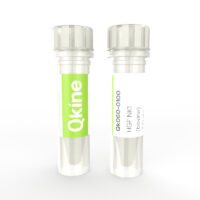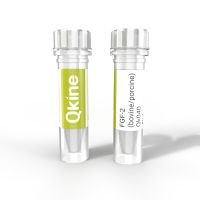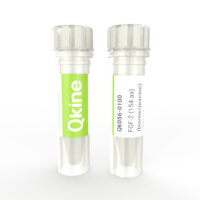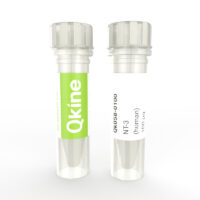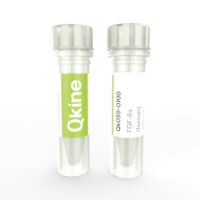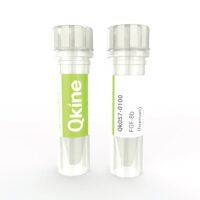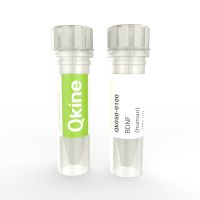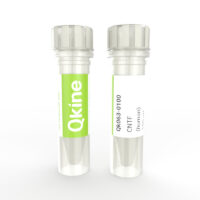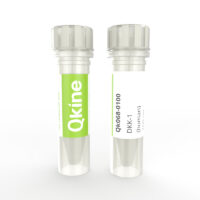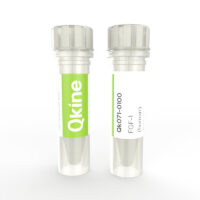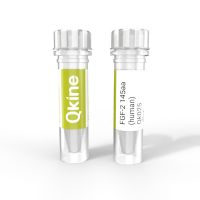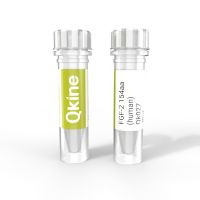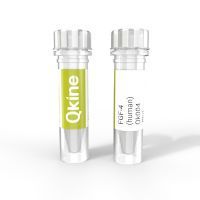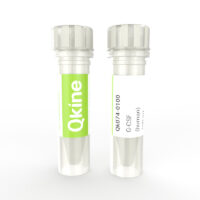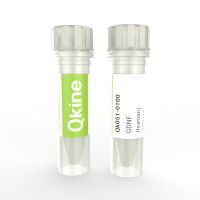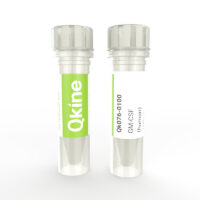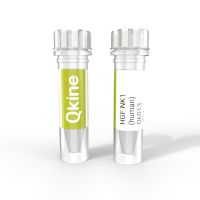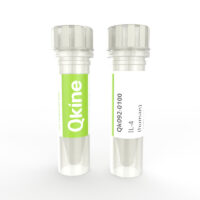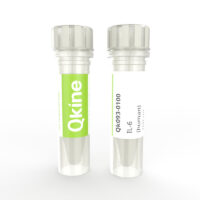- Recombinant bovine HGF protein is a potent, high-purity NK1 isoform of bovine hepatocyte growth factor (HGF). Bovine HGF differs from human HGF at several key amino acid residues that are predicted to affect bioactivity and receptor binding. Use of species-specific HGF growth factor will facilitate media optimization for cellular agriculture (cultivated meat) and veterinary applications. Also available is Qk061 Porcine HGF (NK1). The highly scalable animal-free manufacture and enhanced bioactivity make this suitable for chemically-defined media and reproducible scale-up.20kDa naturally occurring isoform of HGF, animal-free and carrier-protein free.
- Recombinant bovine/porcine FGF2 protein 145 aa (bFGF/basic FGF) for the development of species-specific bovine (cow) and porcine (pig) cellular agriculture protocols and veterinary research applications. Used in comparative cell culture media optimization studies alongside Qk056, the 154aa form of porcine/bovine FGF-2.FGF-2 is used extensively in the maintenance and proliferation of induced pluripotent (iPSC) and embryonic stem cells (ESC)1-3 and for enhancement of proliferation in primary cell culture.High purity 16 kDa FGF-2 / bFGF protein, animal origin-free (AOF) and carrier-protein free (CF).
- Recombinant bovine/porcine FGF2 protein 154 aa (bFGF/basic FGF), this is the long form of FGF-2 used for the development of optimized serum-free culture media for species-specific bovine (cow) and porcine (pig) cultivated meat and veterinary research applications. Used in comparative media optimization studies with Qk040 porcine/bovine FGF-2 145 aa.FGF-2 is used extensively in the maintenance and proliferation of induced pluripotent (iPSC) and embryonic stem cells (ESC)1-3 and for enhancement of proliferation in primary cell culture.High purity 16 kDa FGF-2 / bFGF 154 aa protein, animal origin free (AOF) and carrier-protein free (CF).
- Neurotrophin 3 protein is part of the neurotrophin family and plays a crucial role in embryonic development and the maintenance and neuroprotection of the adult nervous system.NT-3 protein is used in cell culture to promote the differentiation and survival of specific neural subpopulations in both the central nervous system and peripheral nervous system such as sensory neurons, cortical neurons, and oligodendrocytes. It is also involved in the maintenance of endothelial cells and myocardial cells.Recombinant Neurotrophin 3 protein is a non-covalently linked homodimer with a molecular weight of 27.3 kDa.Qkine NT3 protein is animal-free (AOF), carrier-free, tag-free, and non-glycosylated to ensure its purity with exceptional lot-to-lot consistency. It is suitable for the culture of reproducible and high-quality cortical neurons and oligodendrocytes.
- Fibroblast growth factor 8a (FGF-8a) is a member of the FGF family and plays a key role in the regulation of embryogenesis, cellular proliferation, differentiation, and migration. FGF8a is often used for the differentiation of induced pluripotent stem cells, embryonic stem cells, and neural stem cells.FGF8a is a spliced form of FGF8, a heparin-binding protein that targets mammary and non-mammary cells expressing the FGF receptors. A 21.3kDa highly pure, bioactive recombinant protein produced in an animal-free expression system. This protein is animal-origin free (AOF), carrier protein-free, tag-free, and non-glycosylated to ensure a pure homogenous protein with exceptional lot-to-lot consistency. Qk059 is suitable for enhanced reproducibility and physiologically relevant cultures.
- Fibroblast growth factor 8b (FGF-8b) is a member of the FGF family involved in the regulation of embryogenesis, cellular proliferation, differentiation, and migration.FGF8b is commonly used for the differentiation of induced pluripotent stem cells into neural cell types and brain organoid cultures.FGF8b is a spliced form of FGF8, a heparin-binding protein that targets mammary and non-mammary cells expressing the FGF receptors. A 22.5 kDa highly pure, bioactive recombinant protein produced in an animal-free expression system. This protein is carrier-free, tag-free and non-glycosylated to ensure a pure, homogenous protein with exceptional lot-to-lot consistency. Qk057 is suitable for enhanced reproducibility and physiologically relevant cultures.
- Brain-derived neurotrophic factor (BDNF) is a member of neurotrophin family and plays a crucial role in neural development, maintenance, and function. It stimulates neurogenesis and is also a major regulator of synaptic plasticity and neuroprotection. It is used to maintain neurons and differentiate and mature human pluripotent stem cell-derived neural progenitors to cortical and motor neurons and cortical organoids.Recombinant human BDNF protein has a molecular weight of 14 kDa. This protein is animal-free, carrier-free, tag-free, and non-glycosylated to ensure its purity with exceptional lot-to-lot consistency. Qk050 is suitable for the culture of reproducible and high-quality cortical and motor neurons and cortical organoids.
- Ciliary Neurotrophic Factor (CNTF) is a member of the IL-6 family of cytokines. CNTF plays a crucial role in developing and maintaining the nervous system, in particular the optic nervous system. It promotes the maintenance, differentiation, and survival of various neurons, glial cells, and retinal cells.CNTF has been used in vitro to initiate neural induction and differentiation. CNTF can be used to culture primary neurons and glial cells such as astrocytes and Schwann cells. It is also used to culture retinal cells and adipocytes.Human CNTF has a molecular weight of 22.8 kDa. This protein is carrier-free, tag-free, and non-glycosylated to ensure its purity with exceptional lot-to-lot consistency. Qk063 is suitable for the culture of reproducible and high-quality neurons and other relevant cells.
- Dickkopf-related protein 1 (DKK-1) is a key player in the Wnt signaling pathway and regulates embryonic development, tissue balance, and diseases, including cancer. DKK-1 is a member of the DKK protein family and acts as a potent Wnt pathway antagonist.In cell culture, DKK1 is pivotal for controlling cell fate, self-renewal, and differentiation by inhibiting the canonical Wnt/β-catenin pathway through LRP5/6 co-receptors. DKK-1 has been widely used in various applications including guiding stem cell differentiation, particularly in neural and osteogenic pathways, and mimicking dysregulated Wnt signaling seen in cancers. Its inhibitory role is also crucial for anterior development.Human DKK-1 has a molecular weight of 25.7 kDa. This protein is carrier-free and tag-free to ensure its purity with exceptional lot-to-lot consistency. DKK1 is suitable for the culture of reproducible and high-quality stem cells and other relevant cells.
- Human EGF protein is a potent EGF-family growth factor used in many human and mouse organoid and stem cell culture systems including intestinal and tumor (cancer) organoid culture.A pure 6.3 kDa biologically active mature human epidermal growth factor. Our recombinant EGF protein is manufactured to the highest purity in E. coli and extensively tested, making it ideal for use in chemically defined iPSC, ESC and organoid culture media.
- Fibroblast Growth Factor 1 (FGF-1) regulates the proliferation, migration, and differentiation of mesenchymal cells, with roles in embryonic development, tissue regeneration, and wound healing. FGF-1 also has neurotrophic and lipid metabolism functions and can promote hematopoietic stem cell differentiation. It is implicated in tumor growth and migration.In vitro, FGF-1 can stimulate growth and differentiation of endothelial and epithelial cells and the development of organoids. FGF-1 can also be used for the maintenance of oligodendrocytes and astroglia as well as bone marrow-derived mesenchymal and hematopoietic stem cells.Human FGF-1 has a molecular weight of 15.9 kDa. This protein is carrier-free and tag-free to ensure its purity with exceptional lot-to-lot consistency. Qk071 is suitable for the culture of reproducible mesenchymal, endothelial, haematopoietic, glial, and other relevant cells.
- Human FGF2 /bFGF protein (145 aa) is our gold-standard and recommended FGF2 / bFGF protein for induced pluripotent stem cell (iPSC) and embryonic stem cells (ESC) maintenance, and induced pluripotent and mesenchymal stem cells proliferation and differentiation.High purity and bioactivity 17 kDa FGF2 / bFGF protein, animal-derived component free (ACDF) and carrier-protein free (CF) comprising the core structured region (145 amino acids) sufficient for full biological activity.
- Recombinant human FGF2 protein (154 aa) is a highly bioactive, long–form of human fibroblast growth factor 2 protein. FGF-2 protein is used to support the maintenance of human embryonic stem cells and proliferation and differentiation of induced pluripotent and mesenchymal stem cells. This 154 aa form of FGF-2 comprises the core structured region and N-terminal extension.High purity and bioactivity 17 kDa FGF-2 / bFGF protein, animal-free (AOF) and carrier-protein free (CF).
- Human FGF-4 protein is used for the proliferation and differentiation of embryonic and induced-pluripotent and tissue (mesenchymal) stem cells and promotes neural stem cell proliferation. FGF-4 is an important component of cardiac, intestinal and other organoid culture media.High purity and bioactivity 14 kDa, bioactive domain of human fibroblast growth factor 4, animal origin free (AOF) and carrier-protein free.
- Granulocyte colony-stimulating factor (G-CSF) is a member of the hematopoietic growth factor family which plays a crucial role in the proliferation, differentiation, and maturation of committed progenitor cells to granulocytes, such as neutrophils. G-CSF is produced by various cell types including macrophages, fibroblasts, and endothelial cells. It binds to the G-CSF surface receptors upon stimulation to activate key cellular processes involved in neutrophil proliferation, maturation, and mobilization in healthy and diseased states.G-CSF is commonly used in vitro to maintain neutrophils and stimulate the differentiation of cells to neutrophil lineage. is a highly pure, bioactive glycoprotein produced in an animal-free expression system composed of 174 amino acids with a molecular weight of 18.6 kDa. Human and murine G-CSF are 73% identical at the amino acid level and show species cross-reactivity. Human G-CSF is carrier-free, tag-free, and non-glycosylated to ensure a pure and homogenous production of high-quality neutrophils and other relevant cell cultures with exceptional lot-to-lot consistency.
- Glial cell line-derived neurotrophic factor (GDNF) is a member of neurotrophin family and GDNF family of ligands (GFL). GDNF plays a crucial role in the development, growth, and survival of neurons in particular midbrain dopaminergic neurons. It promotes the axon growth and innervation of dopamine neurons. GNDF is used to maintain neurons and cortical organoids and to differentiate dopaminergic neurons from human pluripotent stem cell-derived neural progenitors. GDNF also facilitates the differentiation of neural progenitors to astrocytes.Recombinant human GDNF bioactive 30 kDa homodimer. This protein is animal-free (AOF), carrier protein-free, and tag-free to ensure its purity with exceptional lot-to-lot consistency. Qk051 is suitable for the culture of reproducible and high-quality cortical and motor neurons and cortical organoids.
- Granulocyte-macrophage colony-stimulating factor (GM-CSF) is a hematopoietic growth factor involved in the differentiation and activation of monocytes such as macrophages and dendritic cells, and granulocytes such as neutrophils, eosinophils, and basophils. It is also involved in the development of erythroid, megakaryocytes, and keratinocytes. GM-CSF binds to the GM-CSF receptor (CSF2R) and activates the JAK2/ STAT-5, Ras/ ERK, NF-kB, and PI3K pathways.It is commonly used in cell culture to stimulate the differentiation and maturation of human-induced pluripotent stem cells or peripheral blood monocytes to myeloid cells. GM-CSF can also increase the glycolytic activity of macrophages and promote an M1 polarization.Human GM-CSF is composed of 144 amino acids with a molecular weight of 14.6 kDa. This protein is animal-free, carrier protein-free, tag-free, and non-glycosylated to ensure a homogenous population with exceptional lot-to-lot consistency. Qk076 is suitable for reproducible and high-quality neutrophils and other relevant cell cultures.
- Hepatocyte growth factor (HGF) is a multi-functional cytokine that promotes the growth and proliferation of various cell types including mesenchymal, endothelial, and epithelial cells. It is involved in embryonic development, cell motility, survival, angiogenesis, and tissue regeneration. In cell culture, HGF is used to promote the differentiation of mesenchymal cells towards hepatocytes, osteocytes, and endothelial cells. Recombinant human HFG NK1 protein is a potent naturally occurring isoform of HGF. This protein is animal-free, carrier protein-free, and tag-free to ensure its purity with exceptional lot-to-lot consistency with a molecular weight of 20 kDa. It promotes efficient differentiation of human induced pluripotent stem cells to hepatocyte-like cells at just 10 ng/ml with highly homogeneous expression of the hepatic marker, HNF4α.
- Interleukin-4 (IL-4) is a pleiotropic, immune-modulatory cytokine that is secreted primarily by mast cells, T-cells, eosinophils, and basophils. IL-4 plays a crucial role in hematopoiesis, the regulation of antibody production, the stimulation of activated B cell and T cell proliferation, and the differentiation of B cells into plasma cellsIL-4 induces the expression of class II MHC molecules on resting B-cells and aids regulation of the low-affinity Fc receptor for IgE (CD23) expression on lymphocytes and monocytes. IL-4 additionally is a key regulator in adaptive immunity.Human IL-4 has a molecular weight of 15.1 kDa. This protein is carrier-free and tag-free to ensure its purity with exceptional lot-to-lot consistency. Qk092 is suitable for the culture of reproducible and high-quality stem cells and other relevant cells.
- Interleukin-6 (IL-6) is a multifunctional cytokine that regulates immune responses and inflammation. It is produced by various cells, including immune cells such as T cells and macrophages, as well as non-immune cells like fibroblasts and endothelial cells. IL-6 plays a critical role in infection defense and tissue damage by promoting inflammation and activating immune cells. IL-6 is involved in various physiological processes, including the regulation of metabolism, tissue repair, and hematopoiesis. Human IL-6 has a molecular weight of 20.9 kDa. This protein is carrier-free and tag-free to ensure its purity with exceptional lot-to-lot consistency. Interleukin-6 is suitable for the culture of reproducible and high-quality hematopoietic stem cells and other relevant cells.
